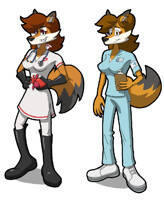
(Interactive pic (kinda)! By opening this sister image in a second tab and flipping between them, you can turn the scan table on and off! http://www.furaffinity.net/view/23368808/ )
The Vscan table represents a revolution in medical imaging. Using highly-focused V-waves, technicians can use the table to render a patient's body translucent in real time. Touch-screen controls allow operators to move the scan window up and down the table, illuminating any portion of the table's occupant. By adjusting the intensity and frequency of the waves, operators can highlight different systems of the patient's body based on their comparative densities, rendering bone structures, muscles, or organ systems in and out of visual focus as desired.
The height of the V-wave field can also be adjusted to account for the sizes of different patients, although field height is typically limited to a roughly 2-foot maximum to keep the equipment operators safely out of its reach. It is strictly ill-advised for an operator to enter the V-wave field without proper protective gear, and some older models of Vscan tables still require operators to wear shielded goggles, gloves, and aprons when inside a Vscan room with the system engaged.
Modern models are typically capable of reading a patient's vital signs and either displaying this data on built-in screens or transmitting it to bedside monitors, as desired.
Here we see a recent Vscan model being used to examine the chest of an AT-series coyote PETT. A testament to the incredible power draw of these machines is the array of massive energy storage banks seen fitted in the room.
Vscan technology was also the catalyst of the infamous "Glass Animals" experiments that have been so thoroughly documented elsewhere.
The Vscan table represents a revolution in medical imaging. Using highly-focused V-waves, technicians can use the table to render a patient's body translucent in real time. Touch-screen controls allow operators to move the scan window up and down the table, illuminating any portion of the table's occupant. By adjusting the intensity and frequency of the waves, operators can highlight different systems of the patient's body based on their comparative densities, rendering bone structures, muscles, or organ systems in and out of visual focus as desired.
The height of the V-wave field can also be adjusted to account for the sizes of different patients, although field height is typically limited to a roughly 2-foot maximum to keep the equipment operators safely out of its reach. It is strictly ill-advised for an operator to enter the V-wave field without proper protective gear, and some older models of Vscan tables still require operators to wear shielded goggles, gloves, and aprons when inside a Vscan room with the system engaged.
Modern models are typically capable of reading a patient's vital signs and either displaying this data on built-in screens or transmitting it to bedside monitors, as desired.
Here we see a recent Vscan model being used to examine the chest of an AT-series coyote PETT. A testament to the incredible power draw of these machines is the array of massive energy storage banks seen fitted in the room.
Vscan technology was also the catalyst of the infamous "Glass Animals" experiments that have been so thoroughly documented elsewhere.
Category All / All
Species Coyote
Size 928 x 1280px
File Size 598 kB
I just remembered, I drew something similar to this awhile back:
http://www.furaffinity.net/view/15684859/
http://www.furaffinity.net/view/15684859/

 FA+
FA+














Comments